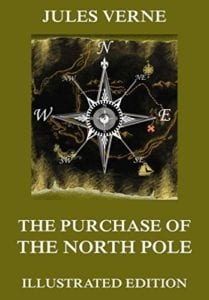
About the Book:
Jules Verne! Among boys a name to conjure with. What memories of half-forgotten books does it bring back! Journeys into the Interior of the Earth, Voyages on Comets, Journeys to the Moon, Submarine Boats—all are creations of his marvellously inventive brain. The Purchase Of the North Pole is a sequel to ” From the Earth to the Moon.” J. T. Maston, the secretary of the Gun Club of Baltimore, evolves the plan of changing, by the discharge and subsequent recoil of a huge cannon, the world’s axis, so as to lay bare the North Pole and the wealth of minerals which it is supposed to contain. The plan is kept secret, but alimited liability company is formed for the purchase of the Folar cap, all the shares being taken up by members of the Gun Club. When, however, the plan is made known the world becomes alarmed the surface of the earth will be changed, whole countries and peoples will be buried under some thousand feet of water, while Britain and Southern Australia will have only the most rarefied air, and measures are taken for the arrest of the directors of the scheme. They have fled, however, and when their whereabouts become known it is to late, they cannot be stopped, and the world resigns itself to its fate. Let the boys, and their elders, see the result for themselves.
Read an Excerpt:
Featured in Feb/Mar 2016 Issue: Climate Fiction
The auctioneer began by saying that contrary to the general rule it was impossible to show the article about to be sold. He could not pass from hand to hand the North Pole. Neither could they examine it nor look at it with a magnifying glass or touch it with their fingers to see whether the plating was real or only artificial, or whether it was an antique, which it really was, he said. It was as old as stone, it was as old as the world, since it dated back to the time the world was made.
If, however, the North Pole was not on the desk of the Public Appraiser, a large chart, clear in view of all interested persons, indicated with marked lines the parts which were going to be sold at auction. Seventeen degrees below the Polar Circle was a red line, clearly seen on the 84th parallel, which marked the section on the globe put up for sale. It appeared that there was only water in this region covered with ice of considerable thickness. But this was the risk of the purchaser. In any case he would not be disappointed in the nature of his merchandise by any representation.
—From The Purchase of the NorthPole by Jules Verne
